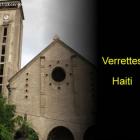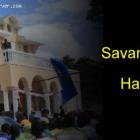ADVERTISEMENT
town - Haiti Observer Blog
town, Haiti Observer Blog. Read the following articles about town
Saint-Rafael Gains Sovereignty from Dominican Republic
Saint-Rafael, a cityship within the Saint-Rafaël Arrondissement, is part of Nord Department. Established in 1761 by Viscount José Meléndez of San Rafaël de la Angostura, the town was originally named after his city, but later shortened to Saint-Raphaël. By 1783, about 1,000 residents populated Saint-Rafaël.
Until 1929, the Dominican Republic (DR) still laid claim to Saint-Rafaël. A treaty signed that year and revised in 1936 sought to reclaim Saint-Rafaël as the domain of its majority population. The revision indicated that residents, who comprised the dominant part of the population in a region, be granted sovereignty. As a result, the DR had to cede considerable land acreage.
Mineral Wealth of Trou-du-Nord will not Benefit Haitians
Trou-du-Nord is a cityship, capital of the Trou-du-Nord Arrondissement, and part of Nord Est Department. It lies in the northeast region of Haiti, with a population of 37,405 residents living in three sub-divisions, Garcin, Roucou and Roche-Plate.
The education system has a smattering of primary and secondary schools, whose students need sponsorships to pay tuition and school supplies. The primary organization offering sponsorships is the L'eglise Baptiste Trou-du-Nord Church, funding the education of 300 schoolchildren at its eponymous school.
The most pressing health challenge in Trou-du-Nord is the presence of malaria that is everywhere. The American Red Cross has a distribution program, whereby it hands out bed-nets to child-bearing women and young children. The program has been an enormous success, lowering the cases of the lethal illness significantly.
Dondon Cave History Intrigues
Dondon, situated within the Saint-Rafaël Arrondissement, is a third-level government division, part of Nord Department. Five rural villages make up Dondon: Bassin Caïman, Laguille, Brostage, Haut du Trou, and Matador. Estimates of the village's population range from 26,000 to 50,000.
Dondon is a farming village that produces coffee, cocoa, lemons, and sugar cane. The village infrastructure is weak, with no access to electric power and no paved roads. Very little auto traffic exists, the main modes of transportation horses and walking. No airport exists either, with the nearest located in Cap Haïtien.
The landscape of Dondon is striking, with mountain ranges, plains, and rivers bordering the village. From the ground floor looking up, an awe-inspiring sight greets the viewer. Colorful dwellings embedded in the mountainsides soar heavenwards, and stunning mountain-peak vistas succumb to plunging ravines everywhere in the village. And the villagers have heard rumors valuable mineral ore is hidden in the ridges burrowed into the mountainside.
Ferrier, originally named Maribeaux
Ferrier is a small cityship contained within the Fort Liberté Arrondissement, part of Nord Est Department. Located in north Haiti, it was established in 1932 and originally named Maribeaux. It was raised to the level of a cityship in 1946 and is comprised of a single commune, Maribaboux.
Farmers in Ferrier engage in sustainable farming. They produce oranges, tobacco, and limes, as well as livestock, to provide for themselves. The land in Ferrier is inadequately irrigated, but is a good place to grow rice, and has received funding from non-government organizations (NGO) to do so.
Infrastructure in Ferrier is underdeveloped. No road or electrical systems exist there, and the town is without an airport. If NGO workers want to travel out of the area, they must access airports miles away, the nearest being Les Cayes, and furthest, Port-au-Prince International Airport. The people in Ferrier also lack a hospital. To get medical attention, they must get to the nearest medical facility located 30 miles out of town in Milot.
The Town of Cabaret and its Challenges
Life has not been easy for people living in Cabaret, which is one of the two towns forming the Arrondissement of Arcahaie in the Ouest Department. About 63,450 people are residing in the town and for the past years, they have faced a lot of challenges, including deaths and calamities.
In 2010, Haiti has been hit by a devastating earthquake that killed tens of thousands of people. In relation with this, Cabaret has witnessed the deadly impact of the calamity as it served as mass graves for the victims. Outside Titanyen, which is one of the settlements in Cabaret, mass graves were dug for the victims of the earthquake. Some parts of the fields were chosen so as to have a place to lay the victims to rest.
Livelihood In the town of Carice, Haiti
Thousands of people live in Carice, a remote town located in the Vallieres arrondissement in Haiti. According to statistics, the town has about 12,000 residents. Carice is a rural area without as many sources of livelihood as in cities and industrialized towns. This is why people rely on agriculture for their main livelihood. Farmers in the town mostly harvest mangoes, bananas and coffee, which are considered the main and most popular products in the area.
Though agriculture is the main source of livelihood in the town, deforestation is still common. As a matter of fact, deforestation affected the soil quality in the town. Despite this, however, the production of crops remains and continues to support people's livelihood.
The Town of Cornillon and its environment
There are many things and factors that contribute to the current condition in Cornillon, a small town in the Arrondissement of Croix-des-Bouquets. It is not a super rich town but its people still have a decent source of livelihood. To know more about the town in the Department of Ouest, here are some more information about it.
Situated in a mountainous region of the southern eastern part of the country, Cornillon has more than 48,900 inhabitants. The town comprises of five sections and witnesses tropical wet and dry weathers.
The town has experienced wide deforestation. This is because settlements were needed. Deforestation was also done in order to give way for more charcoal production. Such production is one of the main sources of income in the town because the demand for coal is high across the country. Because charcoal is the primary source of fuel in Haiti, charcoal product has become one of the highest income-generating livelihoods, especially in Cornillon. However, people do not only rely on charcoal production to make ends meet. They also produce fruits and coffee. Without agricultural and charcoal productions, residents will probably find it more difficult to get by as the town is not as wealthy as the other cities in the country.
Croix Des Bouquets and The 2010 Earthquake impact
The residential town of Croix Des Bouquets in the Ouest Department used to be clean, peaceful and glamorous. Even if a deadly earthquake rattled the entire country in 2010, Croix Des Bouquets retained its glamour as it was not as affected as the capital of Port-au-Prince. However, the aftermath of the earthquake eventually became destructive and detrimental to Croix Des Bouquets.
As survivors fled Port-au-Prince to seek shelter in other towns and cities, refugees thronged to Croix Des Bouquets. This resulted in a period of chaos, as people continued to come to the town. People began setting up tents for shelters and merchants started to scatter all around. This made the town untidy and unruly, which was such a waste because a lot of developmental programs have been done in the area to keep it clean, peaceful and orderly.
Ganthier And Its Tourism Potential
If there is one place in Haiti where tourists may want to visit, it can be the town of Ganthier in the Arrondissement of Croix-des-Bouquets. The town has a lot of great stuff to offer to tourists. It is known for the production of Haiti arts such as crafts, handiworks and others. There is actually a tourist shop where people can buy souvenirs. Tourists are also fond of Ganthier's environs, as well as the l'étang Saumâtre located near by.
In addition to the regular tourists flocking the city are the pilgrims who arrive every year. Thousands of natives and pilgrims come to Ganthier to visit a holy site called the Calvaire Miracle. Most of the pilgrims are Catholic and Voodoo followers who pray and wish to get rid of their problems and start a new life. In order to signify the challenges and burden they carry, the pilgrims hold stones over their heads.
Mombin-Crochu and Living condition
Many people in the town of Mombin-Crochu in the Vallieres Arrondissement live in poverty. Residents do not have the luxury of living a very comfortable life, as Mombin-Crochu is one of the poor towns in the country. In fact, children are forced to walk barefoot because they do not have money to buy slippers. They also walk just to go to school because only a few have access to donkeys, which are the main transportation in the town.
When it comes to utilities, residents in Mombin-Crochu have to go by without a regular supply of water and electricity because they could not afford it. In order to make fuel and cook, they use charcoal and wood fire.
Our objective is to share with you news and information about Haiti and the people of Haiti. Traditions, habits and the way we were or grew are alive in this site. We highly recommend that you Subscribe to our Newsletter and also share with us some of the things that are memorable and made us unique people.

 Verrettes, Haiti
Verrettes, Haiti  Something to think about
Something to think about  The Town of Savanette, Haiti
The Town of Savanette, Haiti  Haitians are a Proud People
Haitians are a Proud People  Haitian Thanksgiving
Haitian Thanksgiving